Chapter 11
Staying on Time and Getting There with Clock, Calendar, and Maps
The iPod touch was never meant to be a major player in the organizer/PDA world, but that's what it has become. It plays music and video. It lets you send and receive e-mails, read books, takes photos, and play games. Given all that, it should be no surprise that the iPod touch offers several very nice utilities that allow you to manage your time, keep track of your appointments, and set alarms. This chapter introduces you to the Clock, Calendar, and Maps applications and shows you how to get the most from them.
Using the Clock Tools
Your iPod comes with a Clock application. This application is far more flexible and useful than you might first imagine. Although you may think that it would show only a clock face and maybe set a timer, it actually provides four separate and useful time tools.
To launch the application, tap the white clock face icon on the black background, as shown in Figure 11–1.

Figure 11–1. The Clock icon
Along the button bar at the bottom of the Clock application screen are icons for each of the four utilities (see Figure 11–2).

Figure 11–2. The four Clock utilities appear in a button bar at the bottom of the application screen.
World Clock: Use this application to monitor the time for multiple clocks around the world.
Alarm: Set your alarms, both one-time and repeating, with this utility.
Stopwatch: Time events with the iPod touch's built-in stopwatch.
Timer: Set a timer to go off after a specific interval with this utility.
NOTE: All clock utilities continue in the background, even if you're not in the Clock application itself. You can start an alarm, a timer, or the stopwatch and go off to other iPod applications. The utility keeps ticking away as you work on other things.
World Clock
The iPod World Clock utility keeps track of time zones around the world. It's really handy if, for example, you regularly travel or make phone calls across time zones. The iPod touch's World Clock can instantly tell you the time in another city. Load it with your favorite cities, and you have an at-a-glance reference that keeps track of the times and time zones for you.
This utility is smart enough to take into account daylight saving time and other quirks, such as New Delhi being 30 minutes off standard. As Figure 11–3 shows, white clock faces indicate daytime, and black clock faces indicate night.
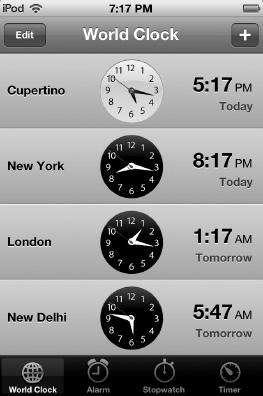
Figure 11–3. The iPod World Clock utility monitors time around the world.
Adding Cities
Tap the + at the top right of the screen to add new cities to the World Clock. A search field pops up, prompting you to search for a city. Tap a few letters of the city name. As you type, a list of matching cities appears below the search field. When you find the city you want to add, tap it. Your new clock appears at the bottom of the World Clock screen.
NOTE: World Clock uses a limited database of cities. You may not find a specific city, town, or village. Instead, look for the nearest large city. For example, if you are interested in the time in Massapequa, Long Island, you'll need to use New York City instead.
Reordering Cities
If the cities do not appear in the order you prefer, tap the Edit button at the top left of the World Clock screen. Grab handles (three parallel gray bars) appear to the right of each clock. Drag these handles to reorder your clocks into any position you like. Tap Done when finished. The World Clock screen updates to reflect your new ordering.
Removing Cities
You can easily remove any or all city clocks from your World Clock screen. Tap Edit (again, at the top left of the screen) to reveal the red remove controls to the left of each city name. Tap any red circle. A Delete button appears to the right of the selected clock. Tap Delete to confirm removal, or tap anywhere else on the screen to cancel the action. Tap Done to leave edit mode and return to the normal World Clock screen.
Alarm
The Alarm utility allows your iPod to alert you at a specified time. Use alarms to wake up in the morning or remember business meetings. Unfortunately, the external speaker for the iPod touch is extremely limited. It's tinny and not very loud, and the set of alarms is minimal. Keep in mind that the alarm works better in quiet locations than in loud ones, and avoid using it for mission-critical events.
Creating Alarms
Create alarms by tapping the + on the Alarm screen. This opens the Add Alarm screen shown in Figure 11–4. From this screen, you can set your alarms as follows.
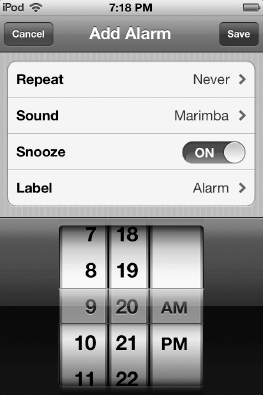
Figure 11–4. Create custom alarms that play sounds at a given time.
Set a time: Spin the wheels to specify the time for the alarm to sound. Drag your finger up and down, and the wheel spins with you. Flick your finger, and the wheel continues spinning, even after your finger leaves the screen. If you like, you can also tap a number rather than spin to it.
Make an alarm repeat: Alarms are day-specific. You must choose days of the week for repeating events. For a daily alarm, select every day from Monday through Sunday. For a weekday alarm, use Monday through Friday instead. I use a weekday-only alarm to remind me ten minutes before I need to pick up my kids at the bus stop.
Select a sound: Choose any of the built-in sounds. They are all quiet. They are all tinny. You'll hear them better if your iPod is plugged into an external speaker system.
Allow snooze: The Snooze button, as you might expect, allows you to delay an alarm and repeat it ten minutes later. To enable this, set the Snooze option to ON. To disable snoozing, set it to OFF.
Label an alarm: Give your alarm a custom label by tapping its name and entering text with the keyboard. This helps you differentiate your alarms at a glance. So, you know which one is “Pick Up Kids at Bus Stop” and which one is “Leave for Dental Appointment.”
Save an alarm: Tap Save to store your new alarm, or tap Cancel to exit the Add Alarm screen without saving the alarm.
Managing Alarms
The main Alarm screen lists all the alarms you've added to your iPod. To manage your alarms, you can do the following:
Activate alarms: Use the ON/OFF toggles to activate or deactivate each alarm.
Remove alarms: To remove an alarm, tap Edit, tap the red button to the left of the alarm name, and then tap Delete. This permanently removes the alarm from your iPod. Tap Done to return to the main alarm screen.
Edit alarms: To edit an alarm, tap Edit, and then tap the gray reveal button (>) to the right of each name. The Edit Alarm screen opens. It looks similar to the Add Alarm screen (Figure 11–4). Make your edits, and tap Save.
Stopwatch
The iPod Stopwatch utility (see Figure 11–5) allows you to time events. On the Stopwatch screen, tap Start to begin the timer, and tap Lap to mark the latest lap time. The laps appear as a scrolling list at the bottom of the screen. Tap Stop to pause. Tapping Reset returns the timer to 00:00.0.

Figure 11–5. The Stopwatch application allows you to keep track of lap times in a scrolling list at the bottom of the screen. Tap Start to start, Stop to stop, Lap to end a lap, and Reset to return the time to zero and erase the lap times.
Timer
The iPod Timer utility (Figure 11–6) plays a sound after a set period of time. Unlike alarms, timers are not tied to a particular time of day. Use alarms for appointments; use timers for cooking eggs. On the Timer screen, set the amount of time you want to pass (three minutes, ten minutes, one hour, and so on), and then tap Start. After the timer counts down, it plays one of the standard alert tones you've selected.
TIP: During the timer countdown, you can select a different alarm tone or cancel the timer before it finishes.
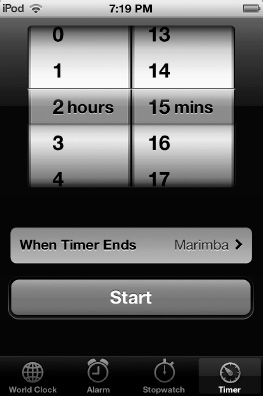
Figure 11–6. Use the Timer application to play an alarm after a set period.
Working with the Calendar
The iPod touch Calendar application allows you to keep track of your appointments while on the go. With it, you can view your existing events and add new ones.
Launch Calendar by tapping the white-and-red icon that looks like a page from an old-fashioned, tear-off calendar (see Figure 11–7). The day and date are current and update every day.

Figure 11–7. The Calendar icon appears on the top row of your iPod touch home screen and shows the current date.
Switching Calendar Views
The Calendar application offers four views: List, Day, Week, and Month. Each of these helps you locate and review your appointments.
List View
The List view does exactly what the name suggests. It displays your calendar events as a scrolling list. The list is ordered by day and time, as shown in Figure 11–8. The easy-to-follow formatting groups all events on a single day together. All events are listed, providing a powerful overview of all upcoming happenings.

Figure 11–8. Use the List view to see your appointments as a scrolling list.
Here are a couple of points about the List view:
- Tap any event to view it in more detail.
- As you scroll, the currently displayed date “sticks” at the top of the screen, even as you scroll through it. It's a very cool but subtle effect.
Day View
Calendar's Day view shows your day's events in day-planner style (see Figure 11–9). Each event occupies a certain amount of space on the layout and is marked with the event and location.
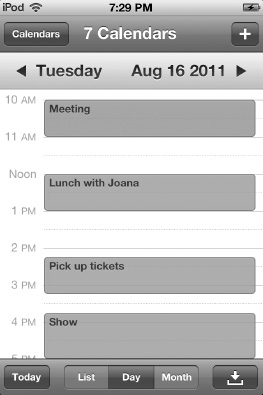
Figure 11–9. View a day at a time with the Day display.
Here are some things you need to know about Day view:
- Tap the previous and next arrows to scroll through your calendar a day at a time.
- The day starts and ends at 12 a.m. So if you schedule your New Year's Eve party from 11 p.m. on December 31 until 2 a.m. on January 1, the Calendar application splits it into two Day views, even though it's a single event.
- Tap an event to open its detail view.
Week View
When you rotate your iPod touch to a landscape position, Calendar's Week view appears (see Figure 11–10). You must rotate your iPod to see the Week view. There is no button in the Calendar app that activates it.
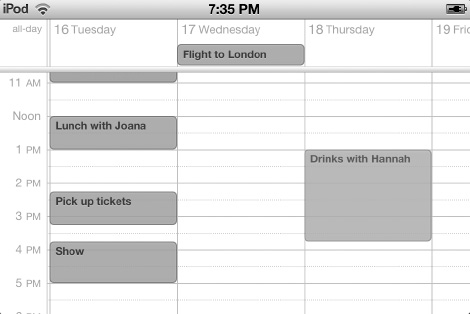
Figure 11–10. View a week at a time with the Week display.
Here are some things you need to know about Day view:
- Swipe left or right to move through the week.
- Swipe up and down to move through the hours of the day.
- Tap an event to open its detail view.
Month View
The month-at-a-time view highlights all days with appointments (see Figure 11–11). A small dot appears below all days containing appointments. Tap any marked day to view a scrolling list of events at the bottom of the screen. As with the other views, tap those events to view their details.
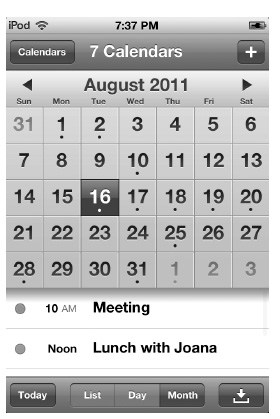
Figure 11–11. The Month view marks a dot under all dates that contain events.
Here are some things you need to know about Day view:
- The darkened, recessed square represents the current date.
- A blue square represents the date you have selected.
- Tap an event to open its detail view.
The Today Button
Clicking the Today button in any view automatically jumps you back to the display for the current day but preserves whichever view you are using. So, you'll see the current month for Month view or recenter the list in List view.
The Calendars Button
The Calendars button at the top left of the screen allows you to choose which calendars you want to show (see Figure 11–12). A calendar with a check mark displays events in any of the calendar views. To hide a certain calendar, tap it to uncheck it.
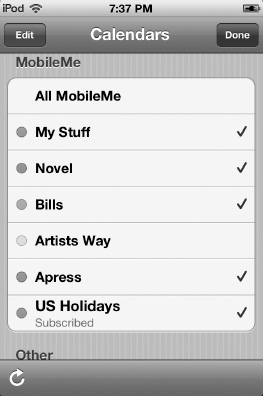
Figure 11–12. The Calendars button screen allows you to choose which calendars you want to show.
You can create new calendars right on your iPod touch. To do so, tap the Edit button in the Calendars window (Figure 11–12). Next, tap Add Calendar and then enter the name of the new calendar and the color you want to use for it. You can also delete and rename any calendar from the same calendar edit screen. Tap Done when finished.
Adding Events
Your iPod touch allows you to add calendar events on the go. This lets you adjust and update your schedule when you are away from your computer. You have two ways to add events. In Day or Week view, you can simply tap and hold on the screen, and a new event bubble appears (Figure 11–13). Drag the grab circles to adjust the times that the event covers. In Week view, you can also drag an event from one day to another.
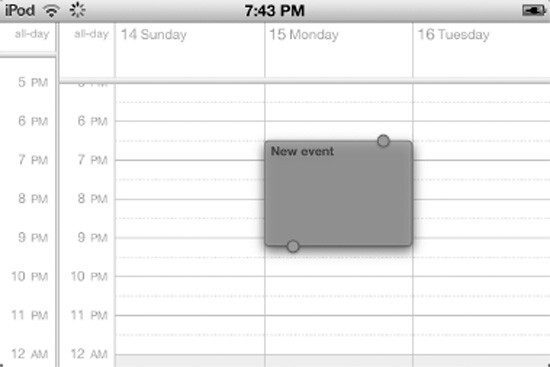
Figure 11–13. Creating new events by touch
If you are in the List, Day, or Month view, you can also add a new event by tapping the + button at the top right of the screen. The Add Event screen opens, as shown in Figure 11–14.
Start by entering a title and location for the event. Tap in either field, and use the keyboard to enter a name and place. To finish naming your event, tap Done, or tap Cancel to leave the screen without adding a new event.
Once you have named your event and tapped Done, you are returned to the Add Event screen. Here, you can update the event name and/or location and specify when the event starts and ends, its time zone, whether it repeats, when to play an alert to notify you about the event, and what calendar the event should appear on (Work, Bills, and so on). You can also add a URL and note to the event. Customize any or all of these options, as described in the following sections, and then tap Done to finish adding the event. Tap Cancel if you want to return to the List, Day, Week, or Month view without adding that event.
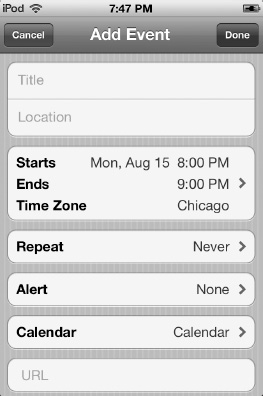
Figure 11–14. Add new events directly on your iPod touch.
Updating an Event Name or Location
Tap the name and location line (just below the Add Event title) to open an editor that allows you to update the event's name and location text. After making your changes, tap Done to save your changes, or tap Cancel to return to the Add Event screen without applying those changes.
Setting the Event Start and End Times
Tap the Starts/Ends field to open the screen that allows you to set these times. You enter the time by way of a scroll control. This control contains date, hour, minute, and a.m./p.m. wheels. You set the start and end time by scrolling your way to the proper combination.
Tap either Starts or Ends to switch between the two times (when the event begins and when it ends) and make your adjustments as needed.
The basic scroller is great for relatively near-term appointments. It is not so great when you're scrolling six months into the future for your next tooth cleaning or your child's commencement schedule. It can take an awful lot of scrolling to get to the date you want. For quicker access to future dates or for all-day events (such as when you go on vacation or will be out of town on a business trip), set the All-day indicator from OFF to ON. The scroll wheel updates, replacing the date/hour/minute wheels with month/day/year wheels. You can schedule appointments this way, all the way up to December 31, 2067. (Don't count on me to be there. I have a tooth-cleaning appointment that afternoon.) You can also set the time zone for the event on this screen.
Tap Done to confirm your settings, or tap Cancel to return to the Add Event screen without changing the start and end times.
Setting a Repeating Event
When your event repeats, you can select from a standard list that defines how often: Every Day, Every Week, Every Two Weeks, Every Month, or Every Year. To make this happen, tap the Repeat field on the Add Event screen, select a repetition interval, and tap Done. To return to the Add Event screen without adding a repeated event, tap Cancel. To disable repeats, tap None, and then tap Done.
Adding Alerts
Add event alerts to notify you when an event is coming due. For example, you may want a one-hour notice for those dental appointments and a two-day notice for your anniversary. The iPod provides a nice selection of options. These include five, fifteen, and thirty minutes before the event; one or two hours before the event; one or two days before the event; and on the date of the event itself.
Tap the Alert field to set an event alert. After selecting an event alert time, tap Done. To cancel without setting the alert time, tap Cancel. To remove event alerts, tap None and then Done.
Once you've saved your first alert, the iPod offers you the option to add a second one. This allows you to remind yourself both a day before an event and a few minutes before you need to leave. This is a particularly useful feature for people who need extra reminders.
NOTE: Unfortunately, there are no “snooze” options for calendar events.
Assigning Event to a Specific Calendar
You can select which calendar the event is assigned to by tapping Calendar and then selecting which calendar the event belongs on from the checklist.
Adding URLs
If there is a web site associated with the event, you can type its web address (URL) into the URL field.
Adding Notes
You can also add a free-form note to your event. Tap the Notes field at the bottom of Add Event screen, and use the Notes screen with its built-in keyboard to set the details for your event, such as phone numbers or names. As with all the other customization options, tap Done to save the note, or tap Cancel to return to the Add Event screen without saving it.
Editing and Removing Events
Tap any event in any view (List, Day, Week, or Month) to edit it. This opens an event detail view. On this screen, you'll see an Edit button at the top-right corner. Tap it to open the Edit screen. This screen is a near twin to the Add Event screen (Figure 11–14) and offers all the same customization options found there.
To remove any event, select it, go to its detail view, and tap Edit. The Edit screen opens. Scroll to the very bottom of the screen, and locate the red Delete Event bar. Tap it. The iPod prompts you to confirm. Tap the red Delete Event bar a second time to remove the event, or tap Cancel to cancel deleting the event.
Synchronizing Calendars with Your Computer
Once you set up iTunes, you can synchronize your iPod touch to your Microsoft Outlook calendars (Windows) or iCal and Microsoft Entourage (Office 2008 or earlier) or Outlook (Office 2011 or later) calendars (Mac). We've told you how to do this in Chapter 2 already, but here's a quick overview.
In iTunes, choose your iPod touch in the source list, and click the Info tab. Scroll down to find the Calendars section (see Figure 11–15), and use the settings there to specify how your touch synchronizes with your computer-based calendars.

Figure 11–15. Choose how to synchronize your iPod touch calendars to your computer by using the Info tab in iTunes.
Select the top check box to enable calendar synchronization. Then choose whether to synchronize all calendars or just those calendars you specify. You can also set a statute of limitations on how far back you want to synchronize events. The default settings do not sync events older than a month.
These settings also let you specify the calendar to which you want to add new events from your iPod touch. You don't have multiple calendars on the touch, but you can control the way the touch interacts with multiple calendars on your computer. Simply select the calendar using the pop-up list.
If, at any time, you want to completely update the calendars on your iPod touch, scroll down to the bottom of the Info screen and locate the Advanced options. Check the box that indicates you want to replace information on this iPod for calendars. After setting this option, the next time you sync (and only during that next sync), iTunes completely replaces the calendar on your iPod with the information from your computer. Use this option when you set up your iPod touch with a new home computer after it was previously synchronized to another host.
NOTE: If you are using Apple's free iCloud storage and sync service (www.icloud.com), your calendars will automatically sync across all your devices whenever you make a change. You'll never have to worry about having to remember to sync again!
Exploring with Maps
The Maps app uses Google Maps interactively to find and display locations using map and satellite imagery. With Maps (Figure 11–16), you can get directions, view traffic, and more. Launch the app by tapping the Maps icon. It looks like a small map and actually shows the location of Apple on 1 Infinite Drive in Cupertino, California. This takes you into the Maps application, where you can view and explore geography from around the world.

Figure 11–16. The Maps icon
Getting Around the Maps Screen
Figure 11–17 shows the basic Maps interface. It consists of the following:
Search field: Marked with a magnifying glass, the search field allows you to enter addresses and other queries. You can type an entire address (“1600 Pennsylvania Avenue, Washington, DC”) or search for contacts (“Bill Smith”), landmarks (“Golden Gate Bridge”), or even pizza places in your local zip code (“Pizza 11746”).
Bookmarks button: This blue book-looking button lies within the search field. Tap it to select addresses from your bookmarked locations, your recent locations, or your contact list.
Map: The map itself appears in the center of your screen. It's fully interactive. You can scroll by dragging your finger along the map, or zoom in and out using pinches and double-taps. (Use a single-fingered double-tap to zoom in and a double-fingered tap to zoom out.)
Red pushpins: The red pushpins indicate locations found by the application after a search. For example, Figure 11–17 shows a café called Curved Angel Café. Tap a pushpin to view a location summary, and then tap the blue > icon for more details and options. These options include directions to and from that location, bookmarking the location, and assigning the location to contacts. Tap the orange-and-white icon with a man in it to enter Street View.
Purple pushpins: The purple pushpins show where you've dropped pins onto the map to add your own user-defined locations.
Locate Me button: Tap the arrowhead button at the lower-left side of the screen to contact Google and search for your location. Google uses a kind of pseudo-GPS position based on your Wi-Fi signal. Some local Wi-Fi networks can return approximate locations within about a half mile and help you determine your location. Other times, Maps thinks you're in Cleveland when you're actually in Arizona. So, don't count on this service; your results will vary.
Search/Directions buttons: The two buttons at the bottom of the screen switch between normal mode and directions mode. Tap Directions to enter start and end locations for your trip or scroll through the stages of your current trip. The directions appear at the top of the screen, along with Previous and Next buttons. When viewing directions, tap the curvy arrow to switch your start and end points and get reverse directions.
Options button: Marked with a page curl icon, this button reveals options hiding below your map. (The map actually bends back to reveal the options.) The list includes the following options:
- Switch between the standard map, satellite, and hybrid imagery or show your directions as a text list, such as “Go west for 5.4 miles.”
- The drop pin feature lets you include additional feature points without needing to enter an address. This is perfect for when you need to remember where you parked the car or saw a cool product in a shop window while walking.
- Choose Show Traffic to request traffic conditions along your route. This feature is limited to certain regions, mostly major metropolitan areas.
- Tap the Print button to print your map and directions to an AirPrint printer.
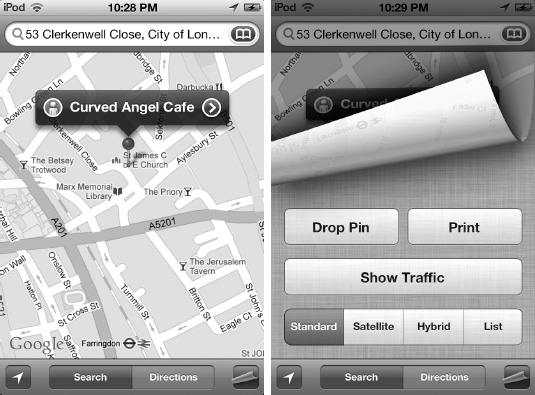
Figure 11–17. The Maps application (left) allows you to interactively view and search standard and satellite maps. The red pushpins show the locations found by your search. Tap the page curl icon in the lower-right corner to be presented with your Maps options (right).
Navigating Maps
The Maps app makes it so you can explore the world from the comfort of your hands. Like any other app, you navigate the map using gestures. You can also view the map in different modes.
Gestures
On maps you use gestures to zoom in, zoom out, pan, and scroll.
Zoom in: You have two ways of zooming in. Either pinch the map with two fingers, or use one finger and double-tap the location on the map that you want to zoom in on. Double-tap again to zoom in even closer.
Zoom out: You can zoom out in two ways. Either reverse-pinch the map with two fingers, or use two fingers double-tap the map. Double-tap with two fingers again to zoom even farther out.
Panning and scrolling: Touch and drag the map up, down, left, or right to move the map around and view another location.
Changing Map Views
The default map view is Google's classic road map with orange, yellow, and white streets. But the Maps application also allows you to view the map in four additional views as well as with traffic overlay.
To access these features, tap or tap and drag the page curl at the bottom of the maps screen. The map curls up, and you are presented with the Map settings page (see Figure 11–17). Your settings include map views, overlays, and a special feature called “Drop Pin,” which places, or “drops,” a pin anywhere on the map. These dropped pins let you easily mark a business, street corner, beach, or any other kind of location on a map.
Standard: This is the classic default map view. It uses Google's standard road map.
Satellite: This view shows you the world using satellite imagery. It's perhaps the coolest maps view because you can zoom in on streets and see little blips of people walking the day the satellite imagery was taken. No labels appear in satellite view.
Hybrid: This view combines Classic and Satellite. You see the map in satellite imagery, but it has labels, roads, and borders overlaid on it.
List: This view shows you your location or direction using a list.
TIP: The standard map view uses orange, yellow, and white to color streets. Orange indicates interstate highways. Yellow indicates state highways and county parkways. White indicates local and private streets.
Show Traffic: Tap to turn Traffic ON. While on, the current traffic conditions are overlaid on the map. To see current traffic conditions, you must be connected to a Wi-Fi network. I'll talk more about traffic later in this chapter.
Drop Pin: Tapping this button causes the page to uncurl and drops a location pin in the center of the map. Use a dropped pin to easily mark a business, street corner, beach, or any other kind of location on a map. You can also drop a pin by touching and holding anywhere on the map. I'll talk more about dropping pins later in this chapter.
You'll notice I said that the Maps app allows you to view the map in standard map view as well as four additional views, so there are five views total. The fifth view is called Street View, and you access it from a search results or dropped pin. I'll talk more about Street View later in this chapter.
Finding Locations
The Maps app provides multiple ways to find locations. You can search for locations using the search field, automatically find your current location using the iPod's Skyhook location services, or even just zoom in and browse the map like a bird flying overhead.
Depending what you are looking for, some types of search are better than others. For example, if you are looking for your favorite spot on a beach, chances are it doesn't have an address or name, so your best bet is to navigate to the beach and then zoom in and scroll around in satellite view until you find that favorite spot.
Search
You'll find most of your locations through the search field at the top of your screen (see Figure 11–17). Tap the search field, and a keyboard appears. There are many ways to search for a location.
Enter your search query and one or more red pins fall onto the map. Imagine you're taking a trip next week to Chicago. As you'll see in Figure 11–18, I searched for “Pizza Chicago.” Several red pins populate the map, all representing pizza places.
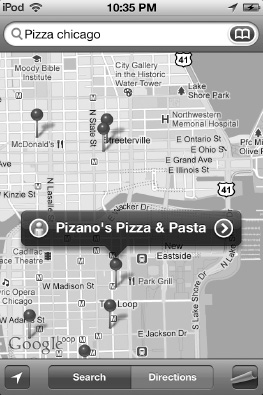
Figure 11–18. Search result pins on the map
When you touch one of the red pins, you get the pin's information bar (see Figure 11–19). The information bar tells you the name of the establishment (a pizzeria, in this case) and displays an icon on either side. Those icons represent the Information window and Street View.
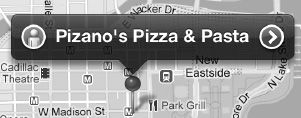
Figure 11–19. A search result pin's information bar shows the name of the establishment with a Street View icon on the left and an Information icon on the right.
Information Window
Tap the white-and-blue > on the pin's information bar to make the Info window slide open. The Info window (see Figure 11–20) displays information for the establishment, such as its phone number, web page, and physical address and gives you several options on how you can use this location further on your iPod touch.

Figure 11–20. The Info window
Phone: The establishment's phone number. Touch and hold to copy the number to the clipboard.
Home page: The establishment's web address. Tap it to close Maps and open the web address in Safari.
Address: The establishment's address. Touch and hold to copy the address to the clipboard.
Directions To Here: Tap here to be taken to the directions toolbar. The address of the establishment is populated in the second (end destination) directions field. I'll talk more about directions later in this chapter.
Directions From Here: Tap here to be taken to the directions toolbar. The address of the establishment is populated in the first (origin destination) directions field.
Add to Contacts: Tapping this button adds the name of the establishment, the phone number, the web address, and the physical address to a contact. You have the options Create New Contact or Add to Existing Contact.
If you choose Create New Contact, a new contact window slides up (see Figure 12–12) in the Info window populating contact fields with information and also allowing you to add more information to the contact. Tap Done to save the new contact.
If you choose Add to Existing Contact, a list of all your contacts from your address book slides up in the Info window. Tap the contact you want to add the information to. The information is added, and the contacts list disappears from view.
Share Location: Tapping this button allows you to e-mail a link of the establishment's name, Google Maps link, and attach a vcard (a virtual business card the receiver can choose to add to his address book).
Add to Bookmarks: Tapping this button allows you to save the location to your Maps bookmarks. You'll be able to name the bookmark, so you can change “Pizano's Pizza & Pasta” to “My favorite pizza joint.” I'll talk more about bookmarks in a moment.
Tap Map to close the information window and return to the map.
Street View
Street View uses Google technology to display 360° panoramic views of the location you are looking at. To enter Street View, tap the white-and-orange Street View icon in the pin's information bar (see Figure 11–19). Your map zooms in on the pin and then tilts up to present you with a street-level panoramic view (see Figure 11–21).
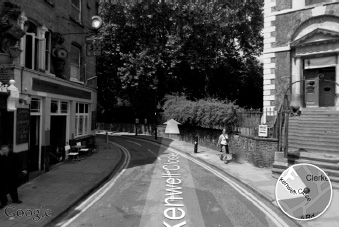
Figure 11–21. Street View fills the entire screen. Tap the white arrow on the road to move forward down the street. Tap the map navigation icon to return to map view.
Google has had Street View available on the Web for some time, but using it on the iPod touch brings it to a whole different level. The fact that you can touch and drag and pinch and zoom around the street gives Street View an immediacy it's never had on a desktop or laptop.
While in Street View, drag your finger around to experience the 360° panoramic views. Pinch or double-tap the screen to zoom in. Reverse-pinch to zoom back out. To “walk” down the street, find the big white arrows at the end of a street label and tap them. You'll then move that direction.
The small circular navigation icon at the bottom right of a Street View map shows you the direction you are looking in. Tap the icon to return to your last map view location.
Street View isn't available in all cities yet, but it is in most major North American and European ones. Street View is a wonderful tool because it lets you check out what a place or area looks like in advance. Thinking of moving to a new area of town? You can virtually scroll down the street in Street View to see whether you like the looks of it before you take the time and trouble to start searching for houses in the neighborhood.
Current Location
Curious about where you are in the world? The Maps app allows you to find your current location with a tap of a button. The current location button is located in the bottom left of the screen (see Figure 11–22). It looks like an arrowhead. Tap it to jump to your current location on the map.
Current Location works by using the iPod's built-in positioning tool called Skyhook Wi-Fi positioning to locate you. Skyhook Wi-Fi positioning uses known wireless hotspot locations to triangulate your current position with an accuracy of 60 to 100 feet (20 to 30 meters).
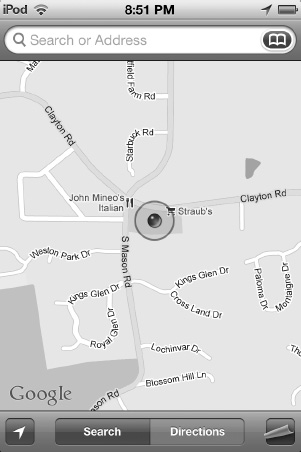
Figure 11–22. The blue dot surrounded by the circle represents your approximate location.
Your current location is signified by a blue dot, as in Figure 11–22. If the Maps app can't determine your exact location, a blue circle appears around the dot. The circle can range in size depending on how precisely your location can be determined. What the circle means is you are somewhere in that location. The smaller the circle, the more precise the current location marker.
NOTE: Location Services must be turned on for your iPod to find your current location. To turn on Location Services, go to Settings ![]()
Location Services ![]()
ON.
When you are in Current Location mode, the current location icon in the toolbar turns blue. If you've found your current location and then drag the map around, you can tap the current location button again to have the map center back on it.
You can tap the blue current location dot on the map to bring up Current Location information bar. The address of the current location is displayed. Tap the > button to get the information window for the location, including the ability to get directions to/from the location, bookmark it, add it to contacts, or e-mail the location; or tap the Street View button to enter Street View (if available in the area).
Bookmarking and Viewing Saved Locations
There are two ways you can bookmark locations you've navigated to in Maps: dropping a pin or tapping the Add to Bookmarks button in the location's information window. Dropping a pin allows you to mark any location on a map, regardless of whether it has a physical address; you can then add the pin's location to your saved bookmarks. Once you've saved locations, you can view them all in the handy Bookmarks menu.
Dropping a Pin
Navigate to a point of interest on the map without doing a search for something. In the example in Figure 11–23, we found a location by Chicago's Shedd Aquarium that has beautiful views of the sunrise over Lake Michigan. To drop a pin, all you have to do is press and hold your finger on the map where you want to drop it. After a second or two, a purple pin appears and sticks in the map.
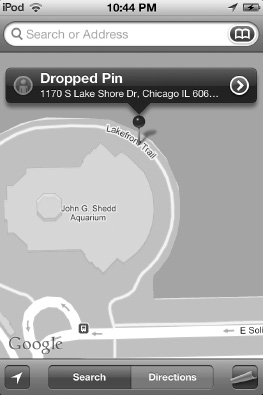
Figure 11–23. A dropped pin and its information bar with the approximate address
The pin's information bar appears with the approximate address of the pin as well as the usual icons for Street View and the information window. If the pin's location isn't exactly where you want it, you can tap and hold the purple pin's head and drag it to the location you want. Remove your finger to sink the pin into the map.
Tap the > button to view the information window for the pin's location, including the ability to get directions to/from the location, bookmark it, add it to contacts, or e-mail the location; or tap the Street View button to enter Street View (if available in the area).
You can also drop a pin in the center of the map by accessing the Maps settings page behind the page curl in the lower-right corner. Tap the page curl at the bottom of the maps screen and tap the Drop Pin button. The settings page uncurls, and a pin drops in the center of the map. You can then tap and drag the pin to move it to anywhere you want on the map.
Dropping pins might seem like a nice but unnecessary feature at first. Why, if you can search maps with the apps powerful search features, would you manually add locations? Again, dropped pins are great because it allows you to mark locations that do not have a fixed address, such as a good trail in the mountains, the sight of your first kiss (for the romantic among you), or even the location of your favorite bench in Central Park.
Bookmarking
So far in this chapter we've shown you several ways to bookmark locations, whether it be by a dropped pin or the information windows of a business, friend, or address you looked up. But where are all those bookmarks you've saved? In the bookmarks window, of course!
Tap the bookmarks icon that's located in the search field (see Figure 11–17). It looks like a book folded open. The bookmarks window appears and presents three views: Bookmarks, Recents, and Contacts (see Figure 11–24).
Bookmarks: This lists all the bookmarks you've saved in the Maps app. Tap any bookmark to jump to it on the map. Tap the Edit button to delete a bookmark, move it up or down the bookmarks list, or change the name of the bookmark.
Recents: This lists all the resent search queries, driving directions, and dropped pins you've made. Tap any item on the list to jump to it on the map. Press the Clear button to remove all items from the list. Remember, clearing your Recents list ensures that people who use your iPod can't spy on locations you've searched for. Be aware, however, that doing so also clears your direction routes. Routes can't be bookmarked, so the only way to quickly access them is through the Recents window. If you clear the window, you'll need to perform your route searches from scratch.
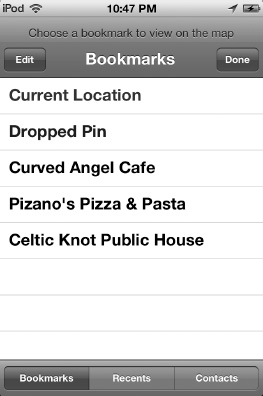
Figure 11–24. The bookmarks window displays your bookmarked locations, recent locations, and contact's locations.
Contacts: This list shows you all the contacts who you have addresses for. Tap any contact on the list to jump to their address on the map. If a contact has more than one address, you'll be asked to choose which address to navigate to. Tap the Groups button to navigate through your contact groups.
Directions and Traffic
The iPod Maps app lets you search for directions and view current traffic conditions. Like the Maps app itself, directions and traffic require an Internet connection. Since the iPod only has a Wi-Fi connection, you'll need to look up the directions before you leave home.
Directions
To get directions, tap the Directions tab in the Maps bottom toolbar (see Figure 11–17). You'll notice that the search field becomes a double field to enter your start and end locations (see Figure 11–25). The Maps app will put your current location, if available, as the starting location. If you don't want to use your current location as the starting address, tap in the first search field, and press the X to remove it and type in whatever address you want.

Figure 11–25. The Maps search field changed to directions input when you tap the directions button.
NOTE: You can also begin a directions search from any pin's information window.
To enter an address from one of your contacts, tap the bookmarks icon, and then choose a contact. You'll be asked to choose whether you want Directions to Here or Directions From Here. Choose, and the contact's address is populated in the appropriate directions field. To reverse the start end points, tap the curvy, sideways S-arrow to switch the points (and get reverse directions). The reverse directions feature is nice because sometimes the route you came isn't the quickest route back. Reverse directions shows you whether another route home is quicker.
When you have selected both a start point and an end point, one or more blue lines appear on the map showing you suggested routes you can take (see Figure 11–26). Tap the route label (Route 1, Route 2, and so on) to select a route. A green pin represents your starting location on the map, and a red pin indicates your end location. You'll also notice a blue directions bar has appeared at the top of the screen. The directions bar lets you choose between driving (car icon), public transit (bus icon), or walking (person icon) directions. These different modes of transportation may give you different direction routes on the map between the exact same two locations. This is because people aren't allowed to walk on highways and cars aren't allowed to drive on pedestrian malls and on certain bus routes, depending on the city you live in.

Figure 11–26. The map with the car route showing three possible routes
Driving or Walking Directions
Tap either the driving or walking icon. You'll see the length of the route and the estimated time it takes to get to your destination. If traffic data is available, the estimated journey time adjusts accordingly.
To navigate through the directions step-by-step, tap the blue Start button in the upper-right corner. The directions bar changes to the one in Figure 11–27.
If you'd like to navigate through the directions step-by-step in the map, tap the right-pointing arrow on the bar. Each subsequent tap brings you forward one step in the route. To move back a step, tap the left arrow.

Figure 11–27. Tap the left or right arrow to move through the directions step-by-step.
Public Transit Directions
Tap the public transit button. In the blue directions bar you'll see the estimated time it takes to get to your destination. If traffic data is available, the estimated journey time is adjusted accordingly.
Tap the clock icon to display a list of departure times and schedules (see Figure 11–28). Tap Depart to choose a date and time. The Depart field defaults to the current date and time unless you change it. Below the depart time is a list of alternate schedules. Select one, and then tap the Done button.

Figure 11–28. The directions bar shows public transit routes (left). The clock icon allows you to select between different transit schedules (right).
To navigate through the directions step-by-step, tap the blue Start button. If you'd like to navigate through the directions step-by-step in the map, tap the right-pointing arrow on the bar. Each subsequent tap will bring you forward one step in the route. To move back a step, tap the left arrow.
NOTE:We've mentioned it before, but unfortunately, you can't bookmark routes. That's a pity because it would be nice to be able to quickly pull up traffic conditions on your favorite routes. Ideally Apple will add this feature in the future.
Traffic
The Maps app can display traffic conditions that help you when planning an immediate journey. To turn on traffic conditions, tap the page curl at the bottom of the maps screen, and then tap Show Traffic to ON (see Figure 11–17). Back on the map you'll notice that green, yellow, and red lines have appeared over some of the roads (see Figure 11–29).
Just how on Earth does the Maps app know what the current traffic conditions are? Most major U.S. cities have sensors embedded in the highways and major roads. These sensors feed data back, in real time, to the Department of Transportation (DOT). The DOT uses this information to update digital traffic signs that report local traffic conditions (like those bright Broadway-like signs that hang from overpasses on major metro highways that tell you how long it will take to get to a certain exit). The DOT also shares this data, which Google collects and uses to display near real-time traffic maps.
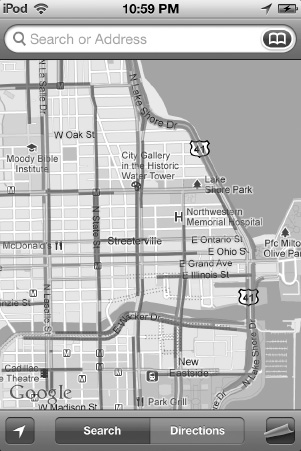
Figure 11–29. Traffic overlays on the map
Green lines indicate traffic is flowing at least 50 mph. Yellow ones mean that traffic is flowing between 25 and 50 mph. Red highways mean that traffic is moving slower than 25 mph. A gray route indicates that traffic data is not available for that street or highway.
The traffic feature is limited to certain regions, mostly major metropolitan areas in the United States, France, Britain, Australia, and Canada, but new cities and new countries are frequently added. If you don't see traffic conditions, try zooming out on the map. If you still don't see any, they aren't available in your area yet.
Maps Tips
Here are some tips for using Google Maps on your iPod:
- When a person or business is in your contacts list, save yourself some time. Don't type in the entire address. Just enter a few letters of the name, and select the contact.
- URLs that link to Google Maps automatically open in the Maps application, whether they are tapped in Safari or Mail.
- Tap individual items on the directions list to jump to that part of your route.
- The Recents screen (in Bookmarks) shows both recent locations and recent directions.
Find a Lost iPod touch
Have you lever lost your iPod? Horrible, right? Don't worry! Now Apple has created a free app called Find My iPhone (Figure 11–30) and you can use it should you ever lose your iPod touch again. Yes, it says “iPhone” but it works for iPads, iPod touches, and Macs as well. Using this app, you can locate all your iDevices from any iPhone, iPad, or iPod touch, or by logging into your iCloud account at www.icloud.com.

Figure 11–30. The Find My iPhone icon.
Before you can find a lost iPod, you need to make sure you've installed and set up the Find My iPhone app on the device. Therefore, it's best to do that as soon as you get your iPod. Once you've set up Find My iPhone to work with your iPod and other iOS devices, launch the app and sign in. You'll then be presented with the screen shown in Figure 11–31.
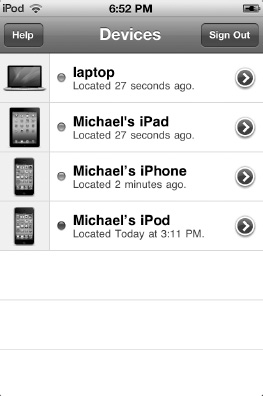
Figure 11–31. The Find My iPhone app lists all your devices. Select one to see its location on a map.
You can choose what Mac or iOS device you want to see the location of. Select a device and it will be located on a map. An iPod touch will be represented by a tiny iPod touch icon. Tap the icon to see the name of the device, then tap the blue Info button to display a window that shows you the various actions you can perform with the device:
- Play Sound or Send Message: This lets you display a text message on your iPod touch or play a sound at full volume for two minutes (even if the iPod is muted). The sound feature is great if you don't know where in the house you have left your iPod or iPhone.
- Remote Lock: Use this to set up a remote passcode lock on your device or initiate your current passcode lock. This will keep anyone out of the device who doesn't know the passcode.
- Remote Wipe: This is a worst-case scenario feature. If your iPod touch has been stolen and you don't want to play detective and track it to the perpetrator's house, you can remote wipe your iPod. Remote wiping your iPod will permanently erase all your personal data on it, ensuring that whoever has or finds your iPod can't commit identity theft against you.
It's important to note that all the Find My iPhone features as they relate to an iPod touch require that the iPod be connected to the Internet to work.
Find a Friend
Your iPod touch is so amaing that not only can it help you find other iOS devices and Macs you own, it can help you find friends as well! Well, not “find friends” as in make new ones, but it can help you find the frineds you already know. It does this through an app (and iCloud service) called Find My Friends (Figure 11–32).

Figure 11–32. The Find My Friends icon.
Using Find My Friends, you can instantly see the location of any of your friends who have iPhones, iPod touches, or iPads. That is, you can see where they are as long as they've given you presmission. The Find My Friends app allows you to also share your location. It's a great way to see where you are in location to your friends. Perhaps you're out shopping and you're thinking of grabbing a coffee. Just open Find My Friends and looks for any buddiess that are near you to meet up for a quick drink.
As you can see in Figure 14-33, all your friends who have allowed you to know their location show up in a list. Tap the friend's name to get the address of where they are and also view their location on a map.
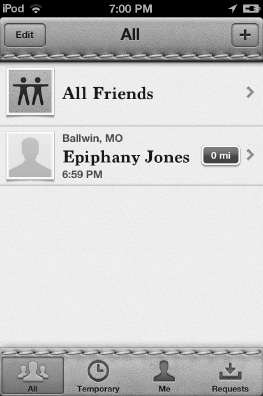
Figure 11–33. The Find My Friends app shows you a list of the locations of all your friends.
And for those of you concerned about privacy know that Apple has built in a great many of privacy options into the app. For instance, you can choose to only share your location for a certain period of time, like three hours; or a certain time of day, like from noon to five pm. You can also revoke all location invitations at any time, which will disable any of your friends from following you.
The Find My Friends app is a great new social netowrking app that's a free download in the App Store. The only requirement is that you have a free iCloud account. Get one at www.icloud.com.
Summary
As you can now see, the iPod touch offers you tools to stay on time and get to places you need to be! Its Clock and Calendar applications certainly complement the other onboard applications and expand usability in a vague time-management way. Maps is the world in your pocket. With it, you can now find directions to your favorite pizza joint, get an instant fix on your current location, or check out what the tops of the Pyramids of Giza look like without leaving your living room. You've learned how to use maps to find public transport times and routes, view current traffic conditions, or just virtually stroll down the street of a neighborhood.
Before we move on to the next chapter, here are a few key points to keep in mind:
- The sound levels for the iPod touch's built-in speaker are pretty good. Still, if you are going to rely on your iPod touch as your only alarm, you may want to buy an iPod speaker system with built-in dock. You'll get much louder sounds, and your iPod is charged while it is plugged into the dock!
- Calendar has four views: List, Day, Week, and Month. Get used to them all because they all provide unique ways of planning and viewing your events.
- You don't have to pop over to Google every time you want to check the current time in London. Set up the World Clock utility and have that information just a couple of taps away.
- Street View is not only fun; it's useful if you want to explore an area of your city—or almost any major city in the world—you've never been to.
- Using your iPod touches built-in positioning features, an iCloud account, and the free Find My iPhone and Find My Friends apps from the App Store, you can now find your missing iOS devices, Macs, and friends all right from the iPod touch!
